Apollo/ New Ratmansky/ New Wheeldon, Royal Ballet | reviews, news & interviews
Apollo/ New Ratmansky/ New Wheeldon, Royal Ballet
Apollo/ New Ratmansky/ New Wheeldon, Royal Ballet
Two world premieres by two celebrated choreographers tick familiar boxes, hey-ho
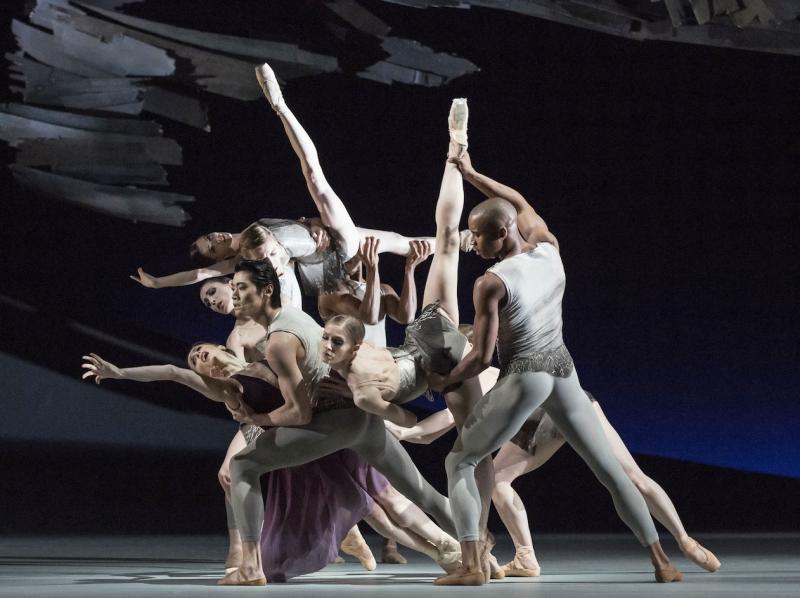
Two world premieres in one night is almost more pressure than anyone can bear - choreographers, commissioning company or audience. Still more when the spotlit dancemakers are probably the two top Western names in the art, Alexei Ratmansky and Christopher Wheeldon. Everyone, but everyone, expects masterpieces.
The curse of Apollo strikes, however. That is Balanchine’s Apollo, still as shockingly new and explicitly thrilling today as it was 85 years ago, and - as an opener on the triple bill - putting down a marker against which the premieres have to compete. A blessing on last night’s opening cast, with Carlos Acosta as sumptuous as a lion in his pride, surrounded by his three lionesses, Marianela Nuñez, Olivia Cowley and Itziar Mendizabal.
Acosta treats the sun metaphor (which Apollo, the god of sun and art, embodies) as the warmth on his back, the light on his face. He thrusts his hands into the air palms up, collecting sunshine, beaming his elemental force back to us with wonderful, almost jazzy sensuousness. It’s a terrific way to be Apollo - nothing grandiose or po-faced about this god, just heat, power and sex. (Below, Acosta as Apollo, Nuñez as Terpsichore)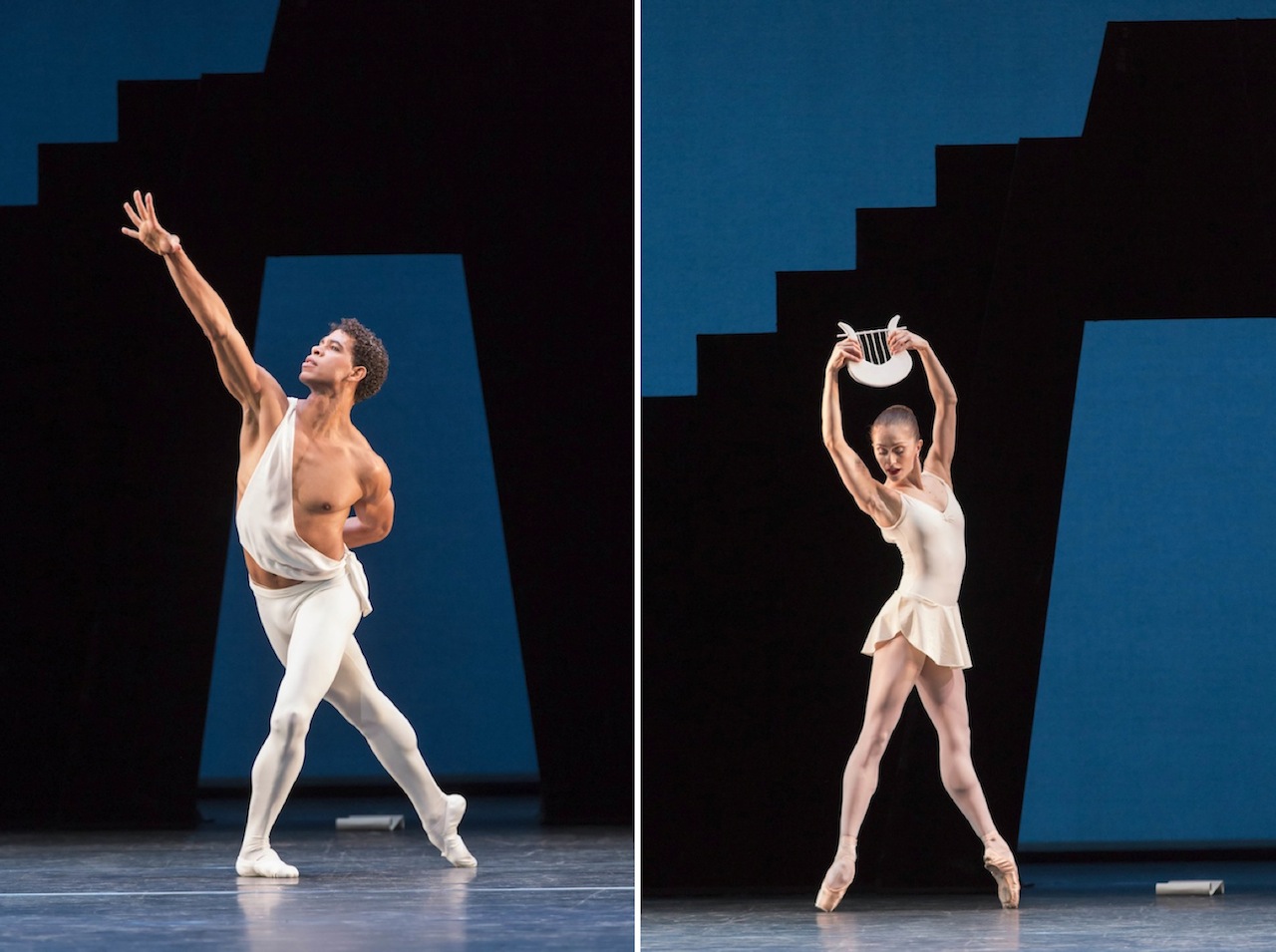
But then follows the hissing sound of deflation. Both Wheeldon and Ratmansky are committed masters of classical ballet for today, each capable on occasion of creations of unique expressive imperativeness. Here, I sense on first view, both have produced work of expected skill, which feel as if they're fulfilling the commissioning company's expectations rather than either of them insisting on saying something keenly personal.
I wanted to be enjoying more than a balletic box of chocolates
One thing united the three works last night: the casual thrashing given to music as a component of ballet. The Apollo was played by the ROH strings under Barry Wordsworth as if sponging a wall with wet rags, rather than addressing the vibrant morning clarity of Stravinsky’s music. That though can be fixed in later performances.
However, Ratmansky, the Bolshoi Ballet’s inspiring and revitalising director from 2004 to 2008, has rot in his new ballet's foundations: he's saddled a drawing-room piece for four star couples with an orchestration of Chopin preludes that turns pellucid piano ephemera into cloying sludge, heavy on cellos, sucking at the ears in horrid un-Chopinesque noises. Meanwhile Wheeldon’s heroic desire to choreograph Benjamin Britten in his centenary year alighted on the undanceable Sinfonia da Requiem. Choreographers, by laying dance over a fine piece of music, are accepting a challenge to add something that, once added, you won’t want to not have. That’s what the 25-year-old Balanchine did with Stravinsky’s Apollo in 1928, and every step in it is blindingly assertive and unexpected, even today.
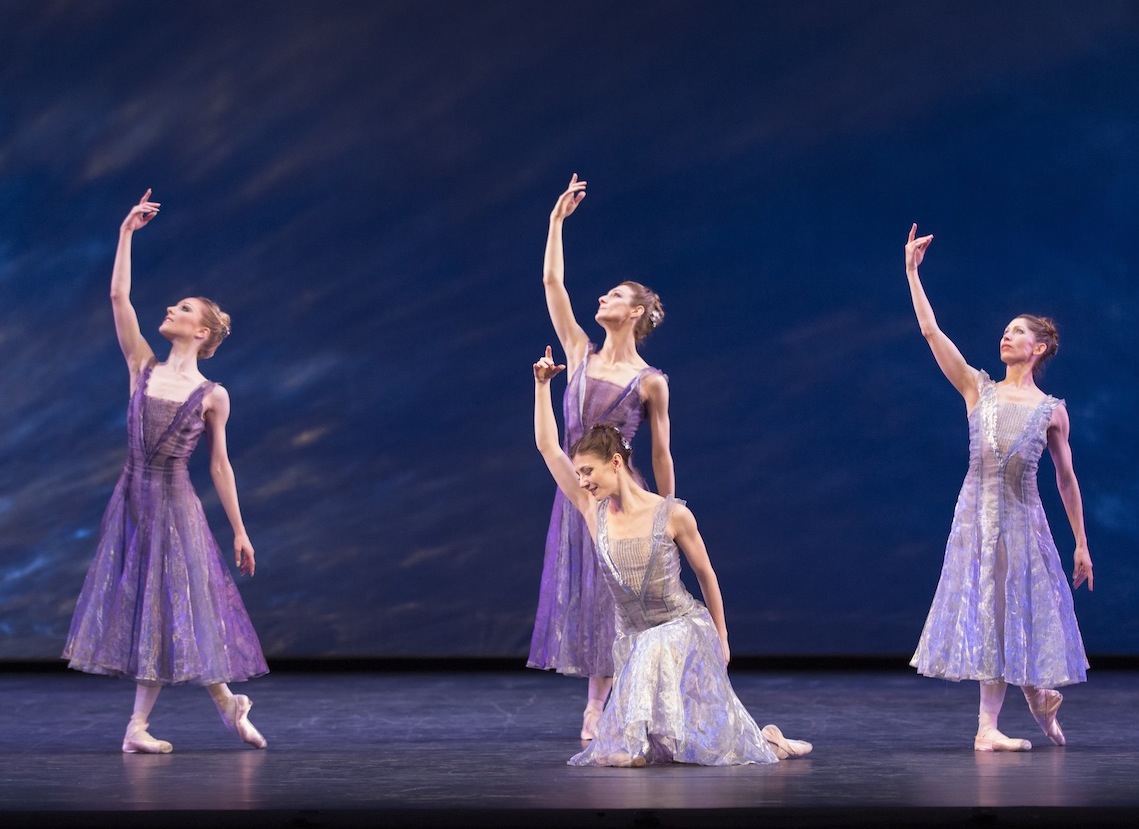 Above, Sarah Lamb, Zenaida Yanowsky, Leanne Benjamin and (front) Alina Cojocaru in 24 Preludes (© Johan Persson/ROH)
Above, Sarah Lamb, Zenaida Yanowsky, Leanne Benjamin and (front) Alina Cojocaru in 24 Preludes (© Johan Persson/ROH)
Emphatically it’s not what Ratmansky has done - if anything the reverse. He should strip out the cloth-eared orchestration of his 24 Preludes and uncover a truer, wittier nature in it as a piano ballet. This has many skilful, even masterly virtues yet somehow it is inconsequential. Like Jerome Robbins's Chopin ballets, Dances at a Gathering or In the Night, it fits a certain genre in Royal Ballet repertoire for elegiac group loveplay, with four fleeting couples swapping in and out of partnerships for 40 minutes, rather longer than they strictly need to.
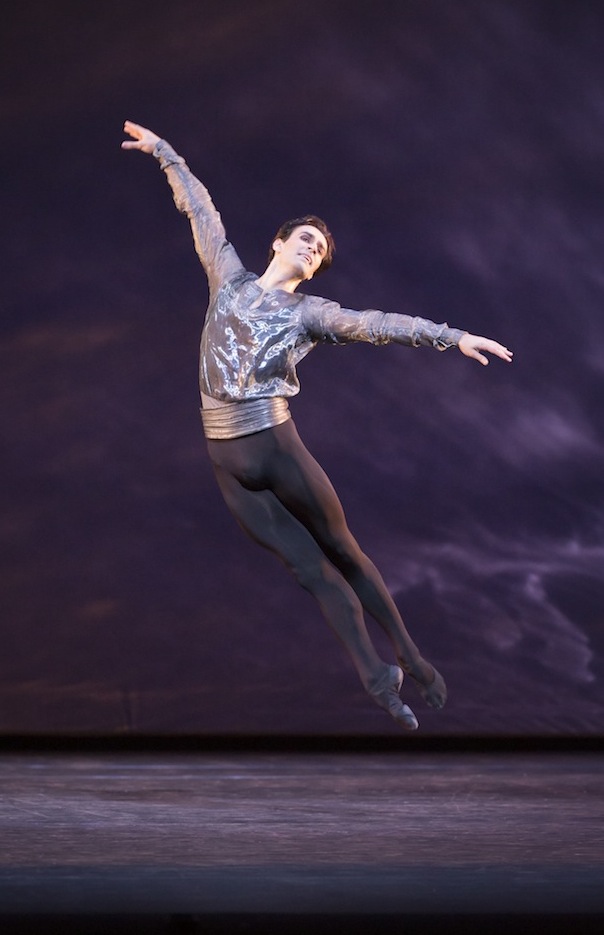 They are, as you expect with Ratmansky, individualised and expressive, and with an unforced, pleasing intimacy. Leanne Benjamin and Alina Cojocaru dance on together, like a pair of happy butterflies. Edward Watson sturms and drangs; Rupert Pennefather does the English gilded youth; Zenaida Yanowsky emotes plangently in a gorgeous solo. So Ratmansky acutely identifies all the fine dancers’ familiar traits for the faithful. (Right, Valery Hristov)
They are, as you expect with Ratmansky, individualised and expressive, and with an unforced, pleasing intimacy. Leanne Benjamin and Alina Cojocaru dance on together, like a pair of happy butterflies. Edward Watson sturms and drangs; Rupert Pennefather does the English gilded youth; Zenaida Yanowsky emotes plangently in a gorgeous solo. So Ratmansky acutely identifies all the fine dancers’ familiar traits for the faithful. (Right, Valery Hristov)
But it should add up, shouldn’t it, to something more than a leisurely gallery of amorously glamorous antics for the Royal Ballet’s A-team? I wanted to be enjoying more than a balletic box of chocolates. Dump the orchestra, put a piano on stage, and maybe more will emerge.
Something of the same wariness of risk undercuts Wheeldon’s Aeternum, a close cousin to his DGV for the Royal Ballet, with another eyewatering set by Jean-Marc Puissant against which the dance struggles to be noticed.
This time, instead of an exploding train, the set's an exploding bag of chips
This time, instead of an exploding train, it’s a gigantic exploding bag of chips, which mesmerisingly flies upwards as the ballet progresses, unfolding into something like the dessicated ribs of a vast dinosaur skeleton. Meanwhile the flooring rises at its corners like a magic carpet preparing for launch, and only the latest Lamborghini model and a coloratura soprano are missing from the display stand.
This is all stridently unsympathetic to Britten’s Sinfonia da Requiem, composed in World War Two with passionate sincerity and a fair bit of declamatoriness of its own.
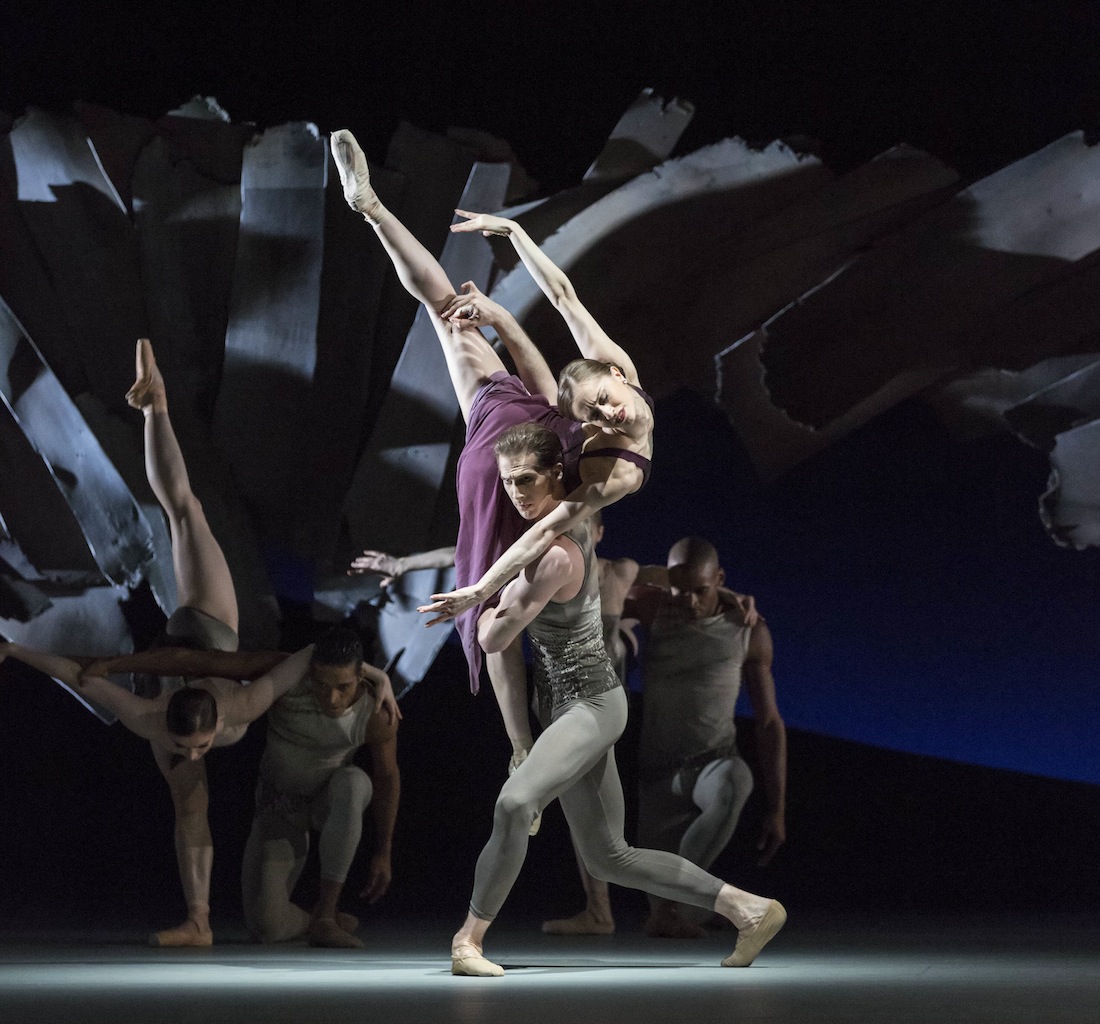 Wheeldon says he intends to hallow the theme of death and resurrection without being specific, but against the bombastic set and hermetically sealed music, his semi-abstract inventiveness feels too noncommittal quite to move the heart or fire the nerves.
Wheeldon says he intends to hallow the theme of death and resurrection without being specific, but against the bombastic set and hermetically sealed music, his semi-abstract inventiveness feels too noncommittal quite to move the heart or fire the nerves.
In contrast to the ensemble sculpture, some of which have an intriguing knotted inventiveness , the bonny Marianela Nuñez offers a more personal "story", starting with Nehemiah Kish as her beau (the two pictured left), and ending with Federico Bonelli, perhaps in an afterlife - you decide. The 18 dancers make gracefully stretched yet undistorted shapes and classical ballet feels freshly swept and deodorised. But considering the striking personality of some of his work in New York and San Francisco, even in Moscow too, I wonder when London is going to be taken by surprise by this talented, puzzling choreographer.
- The Royal Ballet performs this programme today at 12.30pm, twice on 7 March, 9 & 14 March
- See what's on at the Royal Ballet this season
Listen to Britten's Sinfonia da Requiem, played by the Dresden Staatskapelle conducted by Rudolf Kempe:
rating
Share this article
Add comment
The future of Arts Journalism
You can stop theartsdesk.com closing!
We urgently need financing to survive. Our fundraising drive has thus far raised £49,000 but we need to reach £100,000 or we will be forced to close. Please contribute here: https://gofund.me/c3f6033d
And if you can forward this information to anyone who might assist, we’d be grateful.

Subscribe to theartsdesk.com
Thank you for continuing to read our work on theartsdesk.com. For unlimited access to every article in its entirety, including our archive of more than 15,000 pieces, we're asking for £5 per month or £40 per year. We feel it's a very good deal, and hope you do too.
To take a subscription now simply click here.
And if you're looking for that extra gift for a friend or family member, why not treat them to a theartsdesk.com gift subscription?
more Dance
 'We are bowled over!' Thank you for your messages of love and support
Much-appreciated words of commendation from readers and the cultural community
'We are bowled over!' Thank you for your messages of love and support
Much-appreciated words of commendation from readers and the cultural community
 Peaky Blinders: The Redemption of Thomas Shelby, Rambert, Sadler's Wells review - exciting dancing, if you can see it
Six TV series reduced to 100 minutes' dance time doesn't quite compute
Peaky Blinders: The Redemption of Thomas Shelby, Rambert, Sadler's Wells review - exciting dancing, if you can see it
Six TV series reduced to 100 minutes' dance time doesn't quite compute
 Giselle, National Ballet of Japan review - return of a classic, refreshed and impeccably danced
First visit by Miyako Yoshida's company leaves you wanting more
Giselle, National Ballet of Japan review - return of a classic, refreshed and impeccably danced
First visit by Miyako Yoshida's company leaves you wanting more
 Quadrophenia, Sadler's Wells review - missed opportunity to give new stage life to a Who classic
The brilliant cast need a tighter score and a stronger narrative
Quadrophenia, Sadler's Wells review - missed opportunity to give new stage life to a Who classic
The brilliant cast need a tighter score and a stronger narrative
 The Midnight Bell, Sadler's Wells review - a first reprise for one of Matthew Bourne's most compelling shows to date
The after-hours lives of the sad and lonely are drawn with compassion, originality and skill
The Midnight Bell, Sadler's Wells review - a first reprise for one of Matthew Bourne's most compelling shows to date
The after-hours lives of the sad and lonely are drawn with compassion, originality and skill
 Ballet to Broadway: Wheeldon Works, Royal Ballet review - the impressive range and reach of Christopher Wheeldon's craft
The title says it: as dancemaker, as creative magnet, the man clearly works his socks off
Ballet to Broadway: Wheeldon Works, Royal Ballet review - the impressive range and reach of Christopher Wheeldon's craft
The title says it: as dancemaker, as creative magnet, the man clearly works his socks off
 The Forsythe Programme, English National Ballet review - brains, beauty and bravura
Once again the veteran choreographer and maverick William Forsythe raises ENB's game
The Forsythe Programme, English National Ballet review - brains, beauty and bravura
Once again the veteran choreographer and maverick William Forsythe raises ENB's game
 Sad Book, Hackney Empire review - What we feel, what we show, and the many ways we deal with sadness
A book about navigating grief feeds into unusual and compelling dance theatre
Sad Book, Hackney Empire review - What we feel, what we show, and the many ways we deal with sadness
A book about navigating grief feeds into unusual and compelling dance theatre
 Balanchine: Three Signature Works, Royal Ballet review - exuberant, joyful, exhilarating
A triumphant triple bill
Balanchine: Three Signature Works, Royal Ballet review - exuberant, joyful, exhilarating
A triumphant triple bill
 Romeo and Juliet, Royal Ballet review - Shakespeare without the words, with music to die for
Kenneth MacMillan's first and best-loved masterpiece turns 60
Romeo and Juliet, Royal Ballet review - Shakespeare without the words, with music to die for
Kenneth MacMillan's first and best-loved masterpiece turns 60
 Help to give theartsdesk a future!
Support our GoFundMe appeal
Help to give theartsdesk a future!
Support our GoFundMe appeal

Comments
"...as sumptuous as a lion in
A little unfair on two
For a more perceptive take on
Saw this bill at its last